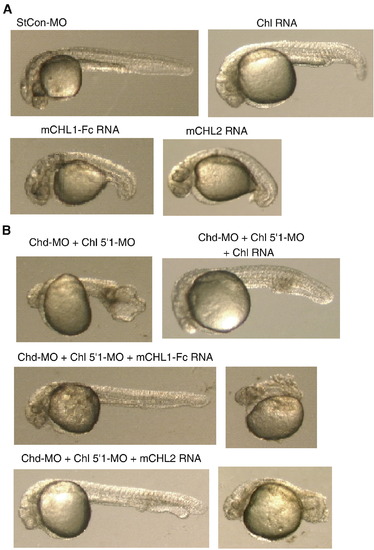Fig. 9
|
Chl and murine CHL1 and CHL2 can rescue embryos ventralized by co-injection of Chl- and Chd-MOs. (A) Embryos were dorsalized by injection of RNA encoding Chl, murine CHL1 fused to an Fc domain (mCHL1-Fc), or CHL2 (mCHL2) (1 ng, 80 pg, or 1 pg, respectively). Also shown, for comparison, is a representative embryo injected with 0.1 mM of StCon-MO. (B) Embryos co-injected with Chd-MO and Chl 5′1-MO are for the most part moderately to severely ventralized, whereas overexpression of Chl RNA rescues embryos co-injected with Chd-MO and Chl 5′1-MO, such that many are only mildly ventralized (shown) or weakly or strongly dorsalized (not shown). Overexpression of murine CHL1-Fc (mCHL1-Fc) or murine CHL2 (mCHL2) also rescued embryos co-injected with Chd-MO and Chl 5′1-MO, resulting in a range of phenotypes that included mildly ventralized (left) and severely dorsalized (right). |
Reprinted from Developmental Biology, 341(2), Branam, A.M., Hoffman, G.G., Pelegri, F., and Greenspan, D.S., Zebrafish Chordin-like and Chordin Are Functionally Redundant in Regulating Patterning of the Dorsoventral Axis, 444-458, Copyright (2010) with permission from Elsevier. Full text @ Dev. Biol.

